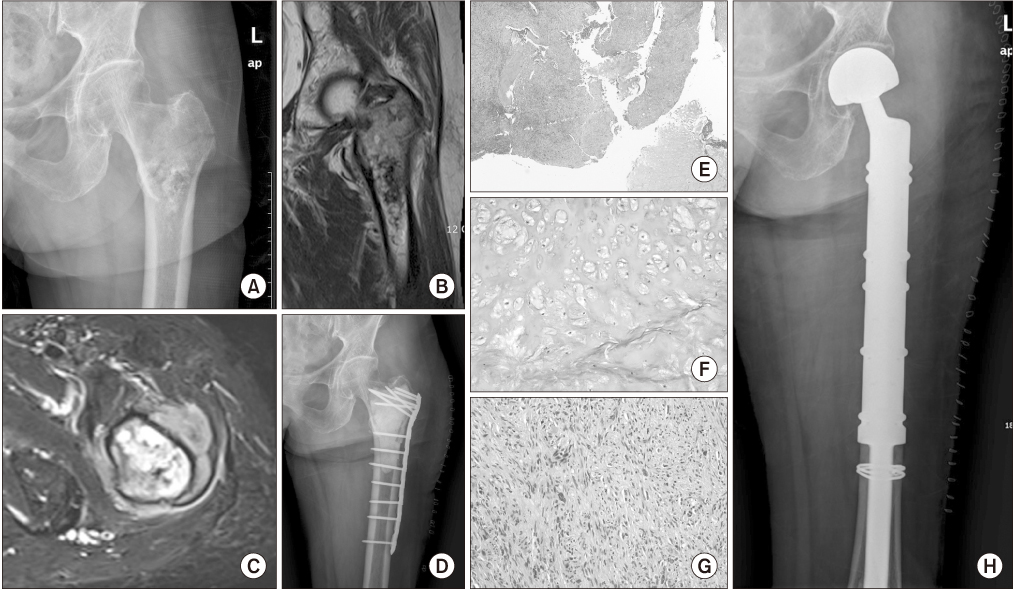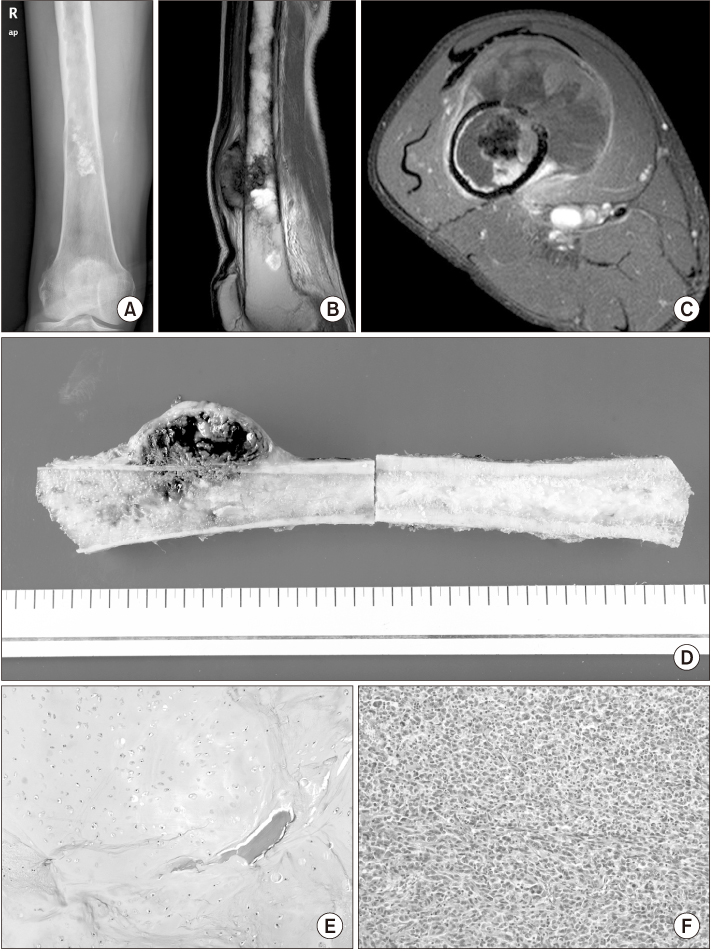J Korean Orthop Assoc.
2019 Apr;54(2):164-171. 10.4055/jkoa.2019.54.2.164.
The Clinical Outcome of Dedifferentiated Chondrosarcoma
- Affiliations
-
- 1Department of Orthopedic Surgery, Korea Cancer Center Hospital, Seoul, Korea. chowanda@naver.com
- 2Department of Pathology, Korea Cancer Center Hospital, Seoul, Korea.
- KMID: 2444782
- DOI: http://doi.org/10.4055/jkoa.2019.54.2.164
Abstract
- PURPOSE
A dedifferentiated chondrosarcoma is a rare lethal tumor characterized by a low grade chondrosarcoma juxtaposed with a high grade dedifferentiated sarcoma, such as osteosarcoma, fibrosarcoma. The aim of our study was to document the clinical manifestation and oncologic outcomes of a dedifferentiated chondrosarcoma.
MATERIALS AND METHODS
This study identified 11 patients who were diagnosed and treated for dedifferentiated chondrosarcoma between January 2007 and December 2016. The identified cohort was then reviewed regarding age, sex, symptom onset, tumor location, magnetic resonance imagings (MRIs), surgical margin, and pathologic diagnosis. The time to local recurrence and/or metastasis, follow-up duration, and the patients' final status were analyzed.
RESULTS
The patients were comprised of 7 males and 4 females with a mean age of 54 years (range, 33-80 years). The location of the tumor was in the femur in 6 cases, pelvis in 4 cases, and metatarsal in 1 case. The average tumor diameter was 12.7 cm (range, 6.0-26.1 cm). At the time of diagnosis, 2 patients showed pathologic fracture; 1 patient was Enecking stage IIA, 9 patients were stage IIB, and 1 patient was stage III. Eight patients were classified as a primary dedifferentiated chondrosarcoma and 3 patients were secondary. One of the primary lesions was misinterpreted initially as a low grade chondroid lesion by MRI and underwent curettage. Local recurrence occurred in 8 cases and distant metastasis occurred in 10 cases with a mean duration of 8 months (range, 2-23 months) and 7 months (range, 1-32 months), respectively. The three-year overall survival of patients with dedifferentiated chondrosarcoma was 18%, and 10 patients died due to disease progression.
CONCLUSION
Dedifferentiated chondrosarcoma developed lung metastases in the early period of the clinical courses and the prognosis was dismal.
MeSH Terms
Figure
Reference
-
1. Dahlin DC, Beabout JW. Dedifferentiation of low-grade chondrosarcomas. Cancer. 1971; 28:461–466.
Article2. Frassica FJ, Unni KK, Beabout JW, Sim FH. Dedifferentiated chondrosarcoma. A report of the clinicopathological features and treatment of seventy-eight cases. J Bone Joint Surg Am. 1986; 68:1197–1205.
Article3. Grimer RJ, Gosheger G, Taminiau A, et al. Dedifferentiated chondrosarcoma: prognostic factors and outcome from a European group. Eur J Cancer. 2007; 43:2060–2065.
Article4. Liu C, Xi Y, Li M, et al. Dedifferentiated chondrosarcoma: radiological features, prognostic factors and survival statistics in 23 patients. PLoS One. 2017; 12:e0173665.
Article5. Staals EL, Bacchini P, Bertoni F. Dedifferentiated central chondrosarcoma. Cancer. 2006; 106:2682–2691.
Article6. Hwang PG, Won JK, Kim MA, Kim HS, Lee SH, Kim CJ. Dedifferentiated chondrosarcoma with giant cell-rich sarcomatous component resembling giant cell tumor: a case report. Korean J Pathol. 2004; 38:345–349.7. Park JH, Koh HS, Lee SY. Dedifferentiated chondrosarcoma from low grade chondrosarcoma. J Korean Bone Joint Tumor Soc. 2005; 11:213–218.8. Enneking WF, Spanier SS, Goodman MA. A system for the surgical staging of musculoskeletal sarcoma. Clin Orthop Relat Res. 1980; (153):106–120.
Article9. Mercuri M, Picci P, Campanacci L, Rulli E. Dedifferentiated chondrosarcoma. Skeletal Radiol. 1995; 24:409–416.
Article10. MacSweeney F, Darby A, Saifuddin A. Dedifferentiated chondrosarcoma of the appendicular skeleton: MRI-pathological correlation. Skeletal Radiol. 2003; 32:671–678.
Article11. Bovée JV, Cleton-Jansen AM, Rosenberg C, Taminiau AH, Cornelisse CJ, Hogendoorn PC. Molecular genetic characterization of both components of a dedifferentiated chondrosarcoma, with implications for its histogenesis. J Pathol. 1999; 189:454–462.12. Têtu B, Ordóñez NG, Ayala AG, Mackay B. Chondrosarcoma with additional mesenchymal component (dedifferentiated chondrosarcoma). II An immunohistochemical and electron microscopic study. Cancer. 1986; 58:287–298.
Article13. Dickey ID, Rose PS, Fuchs B, et al. Dedifferentiated chondrosarcoma: the role of chemotherapy with updated outcomes. J Bone Joint Surg Am. 2004; 86:2412–2418.
Article
- Full Text Links
- Actions
-
Cited
- CITED
-
- Close
- Share
- Similar articles
-
- A Case of Dedifferentiated Chondrosarcoms: It was Changed From a Hamartoma
- Dedifferentiated Chondrosarcoma of the Rib Masquerading as a Giant Chest Wall Tumor in a Teenage Girl: An Unusual Presentation
- Long-term Outcome of Chondrosarcoma: A Single Institutional Experience
- Dedifferentiated Extraskeletal Myxoid Chondrosarcoma of the Masticator Space: A Case Report
- Dedifferentiated Chondrosarcoma with Giant Cell-rich Sarcomatous Component Resembling Giant Cell Tumor: A Case Report




